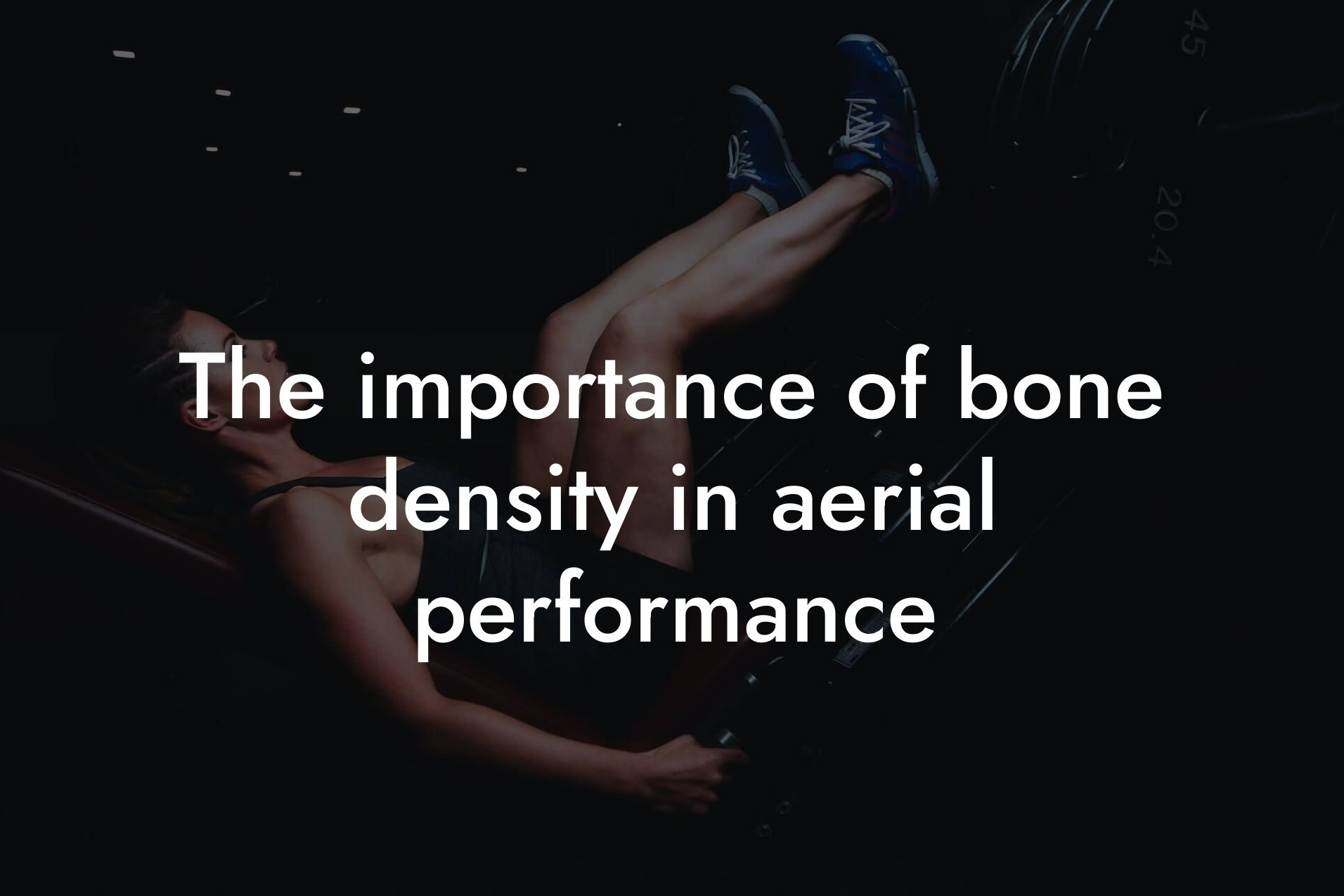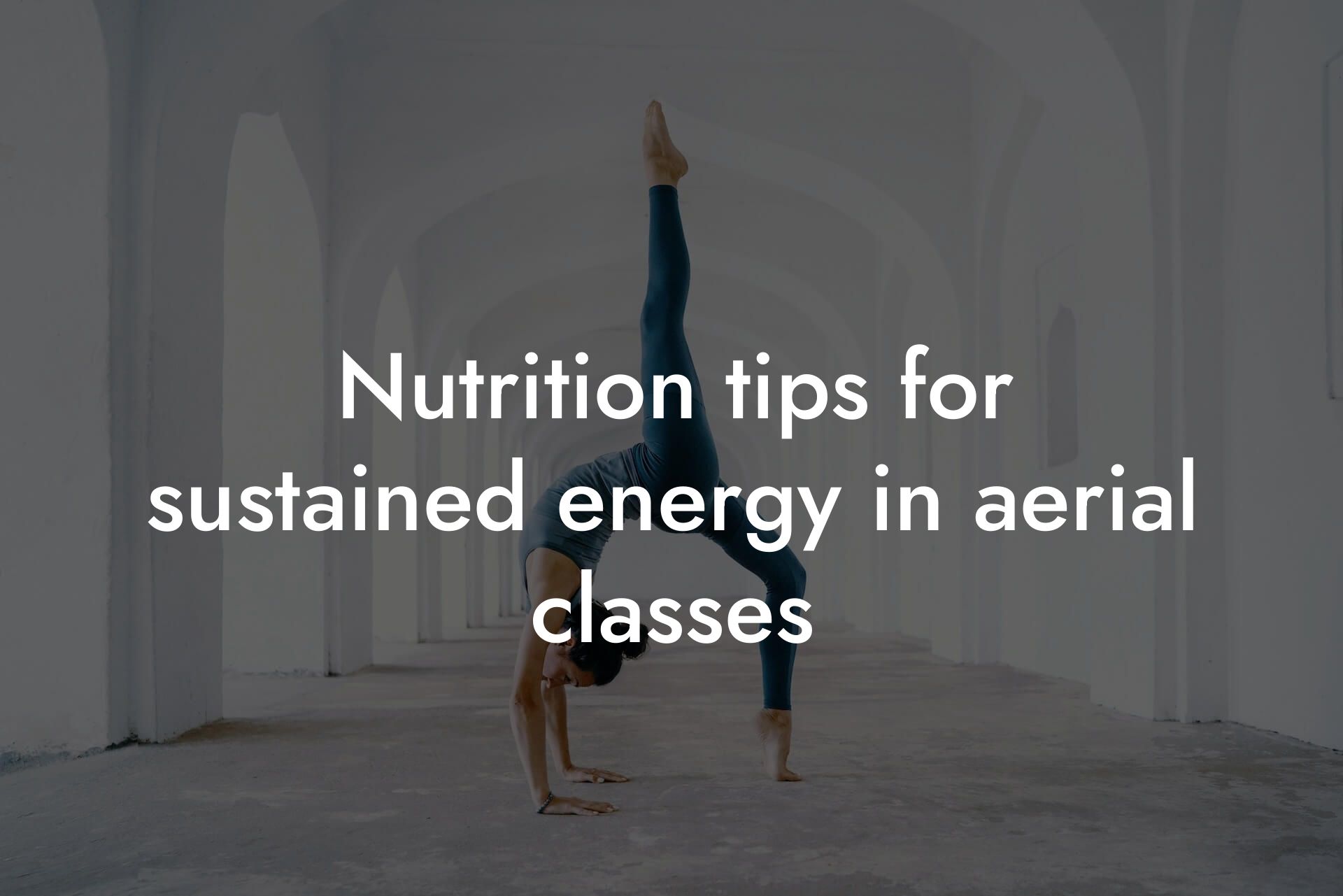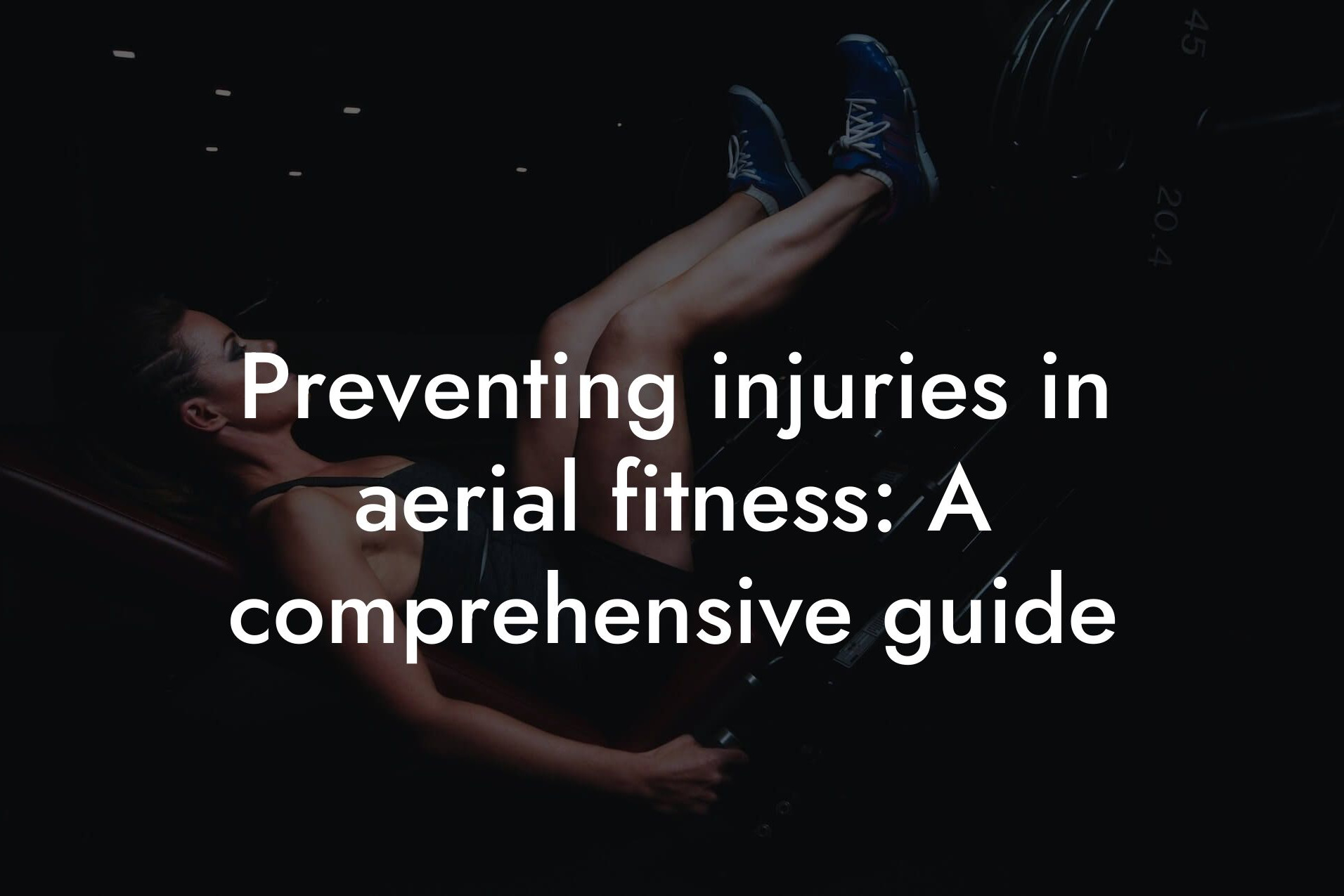As a high-earning professional, taking care of your physical appearance and overall health is crucial for maintaining peak performance in both your personal and professional life. Aerial fitness is an excellent way to improve your physique, increase bone density, and boost your confidence. However, it's essential to strike a balance between strength and flexibility to get the most out of your aerial fitness routine and avoid injuries. In this article, we'll delve into the importance of balancing strength and flexibility, and provide you with practical tips and exercises to help you achieve your aerial fitness goals.
Table of Contents
- Understanding the Importance of Strength in Aerial Fitness
- The Role of Flexibility in Aerial Fitness
- The Risks of Imbalance
- Assessing Your Current Strength and Flexibility
- Exercises to Improve Strength
- Exercises to Improve Flexibility
- Integrating Strength and Flexibility Training
- Frequently Asked Questions
Understanding the Importance of Strength in Aerial Fitness
Strength is a critical component of aerial fitness, as it enables you to support your own body weight, as well as generate power and control while performing aerial movements. Having strong muscles, particularly in your core, arms, and legs, is essential for executing complex aerial skills and maneuvers. A strong upper body is necessary for pulling, pushing, and holding your own weight, while strong legs and core provide stability and control.
In addition to improving your overall aerial performance, building strength also helps prevent injuries. When your muscles are strong, they can absorb and distribute the impact of landings and falls, reducing the risk of strains, sprains, and other injuries.
The Role of Flexibility in Aerial Fitness
Flexibility is equally important in aerial fitness, as it allows for a greater range of motion, reduces muscle tension, and enhances overall performance. When you have good flexibility, you can move more efficiently, with less resistance and strain on your muscles and joints. This enables you to perform complex aerial movements with ease, precision, and control.
Flexibility also plays a crucial role in injury prevention. When your muscles and connective tissues are flexible, they can absorb and distribute the impact of landings and falls more effectively, reducing the risk of injuries. Moreover, good flexibility helps reduce muscle imbalances, which can lead to poor posture, alignment, and movement patterns.
The Risks of Imbalance
When you focus too much on building strength without developing flexibility, or vice versa, you risk creating imbalances in your body. This can lead to a range of problems, including:
- Injuries: Muscle strains, pulls, and tears can occur when you push yourself too hard without adequate flexibility.
- Poor performance: Imbalances can affect your technique, leading to poor performance and decreased confidence.
- Chronic pain: Muscle imbalances can cause chronic pain and discomfort, making it difficult to enjoy your aerial fitness routine.
Assessing Your Current Strength and Flexibility
Before you start working on balancing your strength and flexibility, it's essential to assess your current levels. You can do this by:
- Taking a DEXA scan: A DEXA scan provides a comprehensive assessment of your body composition, including bone density, muscle mass, and body fat percentage.
- Performing a flexibility test: You can use a flexibility test, such as the sit-and-reach test or the shoulder flexibility test, to assess your current range of motion.
- Identifying your strengths and weaknesses: Take note of your strengths and weaknesses in your aerial fitness routine, and identify areas where you need improvement.
Exercises to Improve Strength
To improve your strength, focus on exercises that target your core, arms, and legs. Some effective exercises include:
- Pull-ups and pull-downs: These exercises target your latissimus dorsi, biceps, and shoulders.
- Dips and push-ups: These exercises target your triceps, chest, and shoulders.
- Squats and lunges: These exercises target your legs, glutes, and core.
- Planks and leg raises: These exercises target your core and improve your overall stability and control.
Exercises to Improve Flexibility
To improve your flexibility, focus on exercises that target your major muscle groups, including your hamstrings, quadriceps, hip flexors, and lower back. Some effective exercises include:
- Hamstring stretches: Stand with your feet shoulder-width apart, then bend forward at the hips, keeping your knees straight.
- Quad stretches: Stand with one hand against a wall, then bend one knee, keeping your foot behind you.
- Hip flexor stretches: Kneel on all fours, then bring one knee forward, keeping your foot flat on the ground.
- Lower back stretches: Lie on your back, then bring one knee towards your chest, keeping your other foot flat on the ground.
Integrating Strength and Flexibility Training
To balance your strength and flexibility training, aim to dedicate 2-3 days per week to strength training, and 2-3 days per week to flexibility training. You can also incorporate exercises that combine strength and flexibility, such as:
- Aerial yoga: This combines yoga poses with aerial movements, improving flexibility, strength, and overall aerial performance.
- Aerial Pilates: This combines Pilates exercises with aerial movements, improving core strength, flexibility, and overall aerial performance.
Balancing strength and flexibility is crucial for achieving success in aerial fitness. By understanding the importance of both components, assessing your current levels, and incorporating exercises that target your strengths and weaknesses, you can improve your overall aerial performance, reduce your risk of injury, and take your physique to the next level. Remember to integrate strength and flexibility training into your routine, and don't be afraid to seek professional guidance and support along the way.
Frequently Asked Questions
What is aerial fitness, and how does it relate to strength and flexibility?
Aerial fitness is a form of exercise that involves performing aerial acrobatics and movements while suspended in the air using equipment such as silks, lyra, or trapeze. It requires a balance of strength, flexibility, and control to execute the movements safely and effectively. In aerial fitness, strength is necessary to support the body's weight and generate power, while flexibility is essential to achieve the range of motion required for the movements.
Why is it essential to balance strength and flexibility in aerial fitness?
Balancing strength and flexibility is crucial in aerial fitness because it allows for safe and effective execution of movements. Without sufficient strength, you may struggle to support your body's weight, leading to fatigue, injury, or poor form. On the other hand, without adequate flexibility, you may not be able to achieve the necessary range of motion, limiting your ability to perform movements correctly. A balance between strength and flexibility enables you to move efficiently, reduce the risk of injury, and improve overall performance.
How do I know if I have a good balance of strength and flexibility for aerial fitness?
Evaluating your strength and flexibility is crucial to determine if you have a good balance for aerial fitness. You can assess your strength by performing exercises that target different muscle groups, such as push-ups, pull-ups, and squats. To evaluate your flexibility, you can perform movements that require a range of motion, such as forward bends, side splits, or backbends. Consult with a qualified instructor or trainer to help you assess your strengths and weaknesses and develop a personalized training plan.
What are some exercises that can help improve my strength for aerial fitness?
Exercises that target multiple muscle groups, such as squats, lunges, deadlifts, and rows, can help improve your overall strength for aerial fitness. Additionally, exercises that focus on grip strength, such as grip strengthening exercises or hangs, can be beneficial for aerial movements that require holding onto equipment. It's essential to incorporate a variety of exercises into your training program to ensure overall strength development.
How can I improve my flexibility for aerial fitness?
Improving flexibility for aerial fitness requires a consistent and targeted approach. Incorporate stretching exercises that focus on specific muscle groups, such as hamstrings, hip flexors, and shoulders, into your training program. Hold each stretch for 20-30 seconds and repeat for 2-3 sets. It's also essential to incorporate dynamic stretching, such as leg swings and arm circles, to improve range of motion and reduce injury risk.
What is the importance of core strength in aerial fitness?
Core strength is essential in aerial fitness because it provides stability and control while performing movements. A strong core helps to maintain proper body positioning, generate power, and reduce the risk of injury. Incorporate exercises that target your core, such as planks, Russian twists, and leg raises, into your training program to improve your overall core strength.
How can I prevent injuries in aerial fitness?
Preventing injuries in aerial fitness requires a combination of proper training, equipment maintenance, and safety precautions. Always warm up before training, and start with lower-level movements before progressing to more advanced exercises. Ensure that your equipment is properly installed, maintained, and inspected regularly. Additionally, listen to your body and take regular breaks to avoid fatigue and prevent overtraining.
What are some common mistakes to avoid in aerial fitness?
Common mistakes to avoid in aerial fitness include poor body positioning, inadequate warm-up, and overtraining. Make sure to maintain proper body alignment, engage your core, and use correct technique when performing movements. Avoid pushing yourself too hard, especially if you're new to aerial fitness, and take regular breaks to avoid fatigue.
How often should I train for aerial fitness?
The frequency of training for aerial fitness depends on your goals, current fitness level, and experience. As a beginner, it's recommended to start with 1-2 times per week and gradually increase frequency as you build strength, flexibility, and endurance. For more advanced practitioners, 3-4 times per week may be necessary to continue improving skills and preventing plateaus.
What is the role of nutrition in aerial fitness?
Nutrition plays a critical role in aerial fitness by providing the necessary energy and nutrients for optimal performance. Focus on consuming a balanced diet that includes lean protein, complex carbohydrates, and healthy fats. Adequate hydration is also essential to prevent dehydration and maintain physical performance. Avoid heavy meals before training, and opt for light snacks or meals that are easy to digest.
How can I improve my mental preparation for aerial fitness?
Mental preparation is essential for aerial fitness, as it requires focus, concentration, and confidence. Practice visualization techniques, such as imagining yourself performing movements successfully, to build confidence and mental toughness. Develop a pre-training routine that helps you get focused, such as deep breathing exercises or positive self-talk. Additionally, learn to manage fear and anxiety by reframing negative thoughts and focusing on the present moment.
What is the importance of proper equipment maintenance in aerial fitness?
Proper equipment maintenance is crucial in aerial fitness to ensure safety and prevent equipment failure. Regularly inspect equipment for signs of wear and tear, and perform routine maintenance tasks, such as cleaning and lubricating, to extend the lifespan of your equipment. Always follow the manufacturer's guidelines for maintenance and inspection to ensure compliance with safety standards.
How can I incorporate aerial fitness into my busy schedule?
Incorporating aerial fitness into a busy schedule requires planning and commitment. Start by scheduling training sessions into your calendar, and prioritize them as you would any other important appointment. Consider training early in the morning or during your lunch break to maximize your time. Additionally, look for online classes or tutorials that can be done at home or during travel to maintain consistency and progress.
What are some benefits of aerial fitness beyond physical improvement?
Aerial fitness offers numerous benefits beyond physical improvement, including increased confidence, improved mental focus, and enhanced creativity. It can also provide a sense of community and connection with others who share similar interests. Additionally, aerial fitness can be a fun and exciting way to challenge yourself and push beyond your comfort zone.
How can I find a qualified instructor or training program for aerial fitness?
Finding a qualified instructor or training program for aerial fitness is essential to ensure safety and proper technique. Research local studios or gyms that offer aerial fitness classes, and look for instructors who are certified and experienced. Check online reviews, ask for referrals, and observe a class before committing to a program to ensure it's a good fit for you.
What are some common misconceptions about aerial fitness?
Common misconceptions about aerial fitness include the idea that it's only for young or flexible individuals, or that it's too intimidating or dangerous. However, aerial fitness is accessible to individuals of all ages and fitness levels, and proper training and safety precautions can minimize the risk of injury.
How can I progress to more advanced aerial fitness movements?
Progressing to more advanced aerial fitness movements requires patience, dedication, and a well-structured training program. Start by mastering basic movements and gradually build up to more complex exercises. Focus on developing strength, flexibility, and control, and work with a qualified instructor to identify areas for improvement and provide personalized feedback.
What is the role of breathing and relaxation in aerial fitness?
Proper breathing and relaxation techniques are essential in aerial fitness to reduce stress, improve focus, and enhance overall performance. Practice deep breathing exercises, such as diaphragmatic breathing, to calm the nervous system and improve oxygenation. Additionally, learn to relax and release tension in the body, especially in the shoulders and neck, to improve range of motion and reduce injury risk.
How can I incorporate aerial fitness into my existing workout routine?
Incorporating aerial fitness into your existing workout routine can add variety and challenge to your training. Start by replacing one or two traditional workouts per week with aerial fitness classes or training sessions. You can also incorporate aerial exercises into your strength training or cardio workouts to add an extra challenge and improve overall fitness.
What are some tips for performing aerial fitness movements safely?
Performing aerial fitness movements safely requires attention to proper technique, equipment maintenance, and body awareness. Always warm up before training, and start with lower-level movements before progressing to more advanced exercises. Listen to your body and take regular breaks to avoid fatigue, and never push yourself beyond what feels comfortable and safe.
How can I track my progress and set goals in aerial fitness?
Tracking progress and setting goals in aerial fitness is essential to stay motivated and focused. Set specific, measurable, and achievable goals, such as mastering a new movement or increasing training frequency. Use a training log or journal to track progress, and take progress photos or videos to visualize improvement. Celebrate small victories and adjust goals as needed to stay challenged and engaged.
Here are some related articles you might love...
- The importance of bone density in aerial performance
- Nutrition tips for sustained energy in aerial classes
- Preventing injuries in aerial fitness: A comprehensive guide
- Improving core strength for aerial arts
- Strength training tips specific to aerial fitness
- How body composition affects performance in aerial fitness
- Maintaining muscle recovery with aerial training
- Reducing body fat for improved strength-to-weight ratio in aerial arts
- Using DEXA scans to monitor progress in aerial fitness
Zak Faulkner
Zak Faulkner is a leading authority in the realm of physical health and body composition analysis, with over 15 years of experience helping professionals optimise their fitness and well-being. As one the experts behind Tano Performance Group, Zak has dedicated his career to providing in-depth, science-backed insights that empower clients to elevate their physical performance and overall health.
With extensive knowledge of DEXA technology, Zak specializes in delivering comprehensive body assessments that offer precise data on body fat, muscle mass, bone density, and overall physique. His expertise enables individuals to make informed decisions and achieve their fitness goals with accuracy and confidence. Zak’s approach is rooted in a deep understanding of human physiology, combined with a passion for helping clients unlock their full potential through personalised strategies.
Over the years, Zak has earned a reputation for his commitment to excellence, precision, and client-focused service. His guidance is trusted by top professionals who demand the best when it comes to their health. Whether advising on fitness programs, nutritional strategies, or long-term wellness plans, Zak Faulkner’s insights are a valuable resource for anyone serious about taking their health and fitness to the next level.
At Tano Performance Group, Zak continues to lead our Content Team revolutionising how professionals approach their physical health, offering unparalleled expertise that drives real results.




